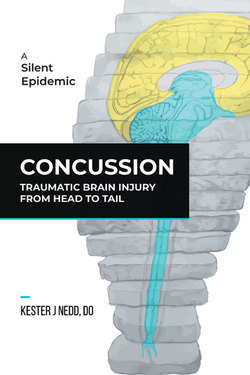Читать книгу Concussion - Kester J Nedd DO - Страница 3
На сайте Литреса книга снята с продажи.
ОглавлениеCONTENTS
Introduction
Part I Defining the Issues
Chapter 1 Tragedy in an instant
Chapter 2 From Head to Tail … What is the BHET Method?
Chapter 3 “A Silent Epidemic” – Traumatic Brain Injury (TBI) and Concussion
Chapter 4 Concepts and terms that better define TBI/concussion in the context of the BHET Method
Part II Features of Cerebral Concussion and TBI
Chapter 5 Key Elements that Define Concussion
Chapter 6 What really happens during a concussion?
Chapter 7 What constitutes an injury?
Chapter 8 Clash of cultures in the field of brain injury
Chapter 9 The Walking Wounded – Missing the diagnosis
Chapter 10 It’s About Time we pay attention!
Chapter 11 Wake up America and Wake up World!
Chapter 12 Conformational Intelligence – Another Point of View
Chapter 13 “Time is Brain”
Part III The BHET Concept
Chapter 14 Understanding BHET? From head to tail…
Chapter 15 The Basis for BHET
Chapter 16 Pillars of the BHET methodology
Part IV Understanding the Anatomical & Physiological Domain
Chapter 17 The Metaphysical Basis of the Human Nervous System Organization – Starting with the Microanatomy and Physiology
Chapter 18 The Human Nervous System – Anatomic Hierarchical Organization – Gross Anatomic Sub-Dimensions
Chapter 19 Cerebral Cortex (Telencephalon) — “The Head” Behavior Structures – Gross Anatomic Sub-dimension (BHET Level 1).
Chapter 20 Diencephalon – The Lower “Head” structures – A Gross anatomic Sub-dimension – (BHET Level 2)
Chapter 21 Brain Stem and Cerebellum – BHET Level 3
Part V When things go wrong
Chapter 22 Disruption of the Cellular Organization and the “On” and “Off” switching mechanisms - A physiological dimension
Chapter 23 The Energy Sink
Chapter 24 Energy and Balance
Chapter 25 Mechanical Forces that Hurt the Brain
Chapter 26 What is the Story of CTE?
Part VI Time, stage and severity domain in the context of the central nervous system hierarchy
Chapter 27 Relationships between Three Dimensions – Time, Stage and Severity of Injury
Chapter 28 Determining Brain Disorganization – Utilizing the TSS Domain (Scoring System)
Part VII The brain as a computer – the input process and output domain (IPO domain)
Chapter 29 How messages get in? The nervous system functioning as a keyboard (input dimension)
Chapter 30 The Nervous System as a Microprocessors – The Processing Dimension
Chapter 31 The Nervous System as an Output Device – The Output Dimensions
Chapter 32 Ranking Input, Output, and Processing
Part VIII The basis for signs and symptoms domain
Chapter 33 A Cluster Versus Hierarchical Approach
Chapter 34 A jigsaw puzzle – The signs and symptoms domain
Chapter 35 Obtaining a Clinical History (Symptoms Dimension)
Chapter 36 Critical Clinical Exam Factors (Signs/Clinical Dimension)
Chapter 37 Organizing the Signs and Symptoms Domains in a Meaningful Way
Chapter 38 Putting Jack Thomas’ Case in Perspective – A Multidimensional Approach
Part IX Cognitive and neurobehavioral domain
Chapter 39 The Cognitive Dimension
Chapter 40 Cortical Function/Cognitive Dimension (Disorders of Attention, Concentration, and Processing Abilities)
Chapter 41 Higher Cortical Function/ Cognitive Dimension – Memory 101 from “Head to Tail”
Chapter 42 How the Brain Handles Retrieval
Part X Making sense! Issues to consider in TBI/ concussion
Chapter 43 Associate Learning – The Most Powerful Form of Learning in Living Organisms
Chapter 44 Executive Functions – Higher Cortical Function/Cognitive Domain
Chapter 45 Information Processing -- Higher Cortical Function/Cognitive Domain
Chapter 46 Communication -- Higher Cortical Functions/Cognitive Domain
Part XI Neurobehavioral dimension
Chapter 47 Neurobehavioral Conditions in TBI/Concussion
Chapter 48 What is the tendency of the brain?
Chapter 49 A Bright Future Ahead?
Credits
